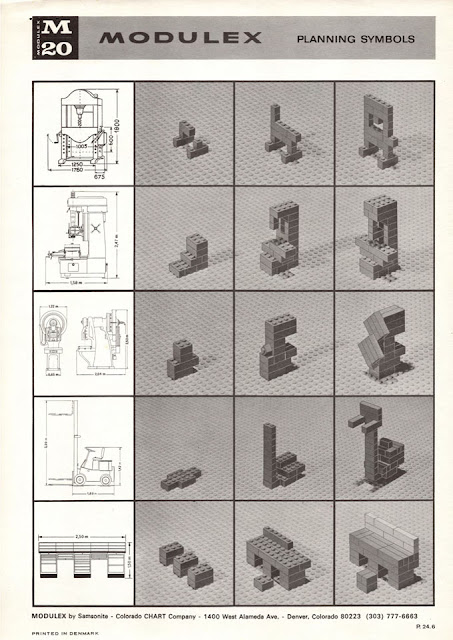We wanted to tell you about a new online resource that collates various historical printed information about Modulex. If you’re unfamiliar with Modulex, it was a separate building system that was introduced by The LEGO Group in the 1960s, intended for scale modelling and project planning.
The Modulex Library has been collated by Rylie Howerter, including scans by Karyn Murphy, Bailey Fullarton and Karwik. Please note that the site is not affiliated with The Modulex Group, and that the scans are archived for historical reference only and are not to be used commercially.
The collection covers a number of years and countries, including some rarer brochures from the USA where, like other LEGO® products of the 1960s, Modulex was licensed to be produced by Samsonite. Further items will be added over time.
Whether you’re a Modulex aficionado or a complete novice, you’ll find items to enjoy in this collection! It’s fascinating to see the range of unusual elements and their potential uses, and the graphic design of the brochures themselves includes some gorgeous examples of minimalist ‘60s design.
We’ve selected a few of our favourites to pique your interest.
These first images demonstrate layout planning, where factory or
production line layouts could be designed, at a variety of scales.
These are examples of some common machine and equipment ‘symbols’ that could be used in layout planning. They were called symbols as the point was to have a rudimentary model that was to scale in all three dimensions, but not to be an exact replica. The brochure suggests taking the main measurements of the machine and then using squared 5mm paper to draw the primary views of height, width and depth, before building with the appropriate Modulex parts. Spot the sideways-building technique!
Four gentlemen in suits pouring over a detailed layout of their new building layout. The one smoking the pipe must be important. I love the intensity of their faces!
With the bricks being 1:1 ratio, Modulex was perfect for architectural modelling. The range included gentle slopes (much earlier than LEGO System did) that are studless; as well as angled bricks for creating roofs; and bricks featuring multiple kinds of texturing to simulate different walls.
Modulex was also intended as a planning system. In the decades before computers, project managers had to find other ways to create timelines! The flexibility of using construction bricks made some updates much easier than using paper.
These images from a French brochure suggest it can even be used for a variety of graphs! Move over, Excel.
About LEGO Modulex bricks
If you’re new to the mysteries of Modulex, check out our other helpful articles!
- Francesco Spreafico of Old Bricks explains the history of Modulex, where to buy Modulex bricks, and also lists more web pages with resources and information.
- Can you connect Modulex and LEGO bricks to use in your own creations? Yes! Ralf Langer (ranghaal) explains some Modulex techniques and gives examples from his own MOCs.
READ MORE: Visit the Modulex Library
Help New Elementary keep publishing articles like this. Become a Patron!
A huge thank you to all our patrons for your support, especially our 'Vibrant Coral' tier: London AFOLs, Antonio Serra, Beyond the Brick, Huw Millington, Big B Bricks, Dave Schefcik, David and Breda Fennell, Gerald Lasser, Baixo LMmodels, Sue Ann Barber and Trevor Clark, Markus Rollbühler, Elspeth De Montes, Megan Lum, Andy Price, Chuck Hagenbuch, Jf, Wayne R. Tyler, Daniel Church, Lukas Kurth (StoneWars) and Timo Luehnen! We love being 1:1 with you.
LEGO® Shop at Home
USA: FREE SHIPPING every day on orders over $35!
UK: Free delivery when you spend £50 or more at LEGO!
Australia:
Discover the latest promotions and offers on LEGO.com
All text © New Elementary. Images © The Modulex Group.









This is so cool! Great idea to store all this in a library. I will take a look at home to see if I have something that is not listed here.
ReplyDeleteI'd love to hear from someone who actually used Modulex back in the day, as it was intended. Was it useful? Did people "get" it? What took it's place?
ReplyDeleteYou should take a look at this great video: https://www.youtube.com/watch?v=x7O-gL3WzSk
DeleteThey also mention it briefly in the book "The LEGO Story" (2022).
Basically, architects thought it was pretty good but a bit expensive. It was also only good for houses with 90 degree angles, so they could use it exactly like they wanted. It was more popular when they made it into a sign system.
That IS a great video!... it screengrabs us :D Thanks o0ger. Here's that link again as a hyperlink https://www.youtube.com/watch?v=x7O-gL3WzSk
DeleteAwesome, thanks oOger!
DeleteThe site ryanhowerter.net is no longer available, but can be reached as ryliehowerter.net.
ReplyDeleteThus, the above link is now https://ryliehowerter.net/mxlib